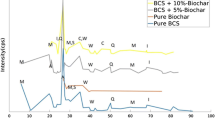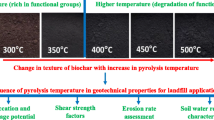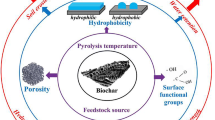Abstract
The present study investigated the influence of biochar on various geotechnical properties of clayey soil. Biochar, a carbon-rich product, was amended with the soil at different percentages such as 5, 10 and 15%. Laboratory tests were conducted to evaluate the feasibility of utilization of biochar in enhancing the integrity of soil slopes with an emphasis on landfill covers and bioengineered slopes. Scanning electron microscopy (SEM) tests were conducted to analyse micro-porous structure of biochar and soil-biochar mix. The SEM micrographs indicated the porous structure of the biochar and a good interaction with the clay particles. It was concluded from the present study that the biochar amended soil can have steeper and stable slopes compared to soil without biochar amendments. The compressibility of the soil was also decreased with biochar amendment.
Access provided by Autonomous University of Puebla. Download conference paper PDF
Similar content being viewed by others
Keywords
1 Introduction
Biochar is a carbon-rich solid product and it can be produced from several types of biomass. Biochar finds its application in carbon sequestration (Lehmann and Joseph 2015), improving agricultural productivity (Das et al. 2016), soil water retention (Bordoloi et al. 2018), contaminant remediation and in preventing landfill gas emissions (Yargicoglu and Reddy 2017), etc. Soil fertility, microbial activity and water holding capacity can be enhanced along with the reduction in leaching of nutrients with the amendment of biochar to the soil. Thus, biochar has the potential to be used in bioengineered slopes. Biochar has a highly porous structure and it was reported that the surface area per gram of biochar range from ten to hundreds of square metres (Lehmann and Joseph 2015).
Biochar amended soil can also be used in landfill covers to reduce landfill gas emission (Reddy et al. 2015). A landfill cover is usually composed of several layers, each with a specific function. The final cover system must enhance surface drainage, vegetation, minimize infiltration and control the release of the landfill gases. In case of bioengineered slopes, the design of surface cover should minimize water infiltration and also maximize shear strength of soils (Bordoloi et al. 2018). In both the applications, vegetation growth should be enhanced in long term. This is exactly, where properties of biochar must be optimized to consider vegetation growth in compacted engineered soil in long term. A preliminary study was conducted to study the influence of biochar on geotechnical properties of compacted clayey soil. Apart from basic index properties, shear strength as well as factor of safety of slope with and without biochar amendment is also investigated.
2 Materials Used in the Present Study
2.1 Biochar
The biochar used in the present study was obtained from pyrolysis of hard wood of Prosopis juliflora. The pyrolysis temperature is around 500 °C. Details of pyrolysis method are mentioned in Bordoloi et al. (2018). Based on the elemental analysis, % carbon (C) in biochar is around 72%, whereas nitrogen (N) is around 0.19%. The C/N ratio is around 382. The cation exchange capacity (CEC) of biochar is around 18 cmol/kg. Figure 2 shows the scanning electron micrographs (SEM) of the biochar. As shown in Fig. 1, biochar has got a highly porous structure.
The structure, however, is slightly different from that reported by Bordoloi et al. (2018). In Bordoloi et al. (2018), SEM images show biochar to be closer to platy structure and was more randomly arranged. However, in this study, the structure of biochar follows a floral pattern. This difference in structure might be due to the difference in source (waste), from where the biochar is produced. It indicates that the source, from where biochar is produced as well as pyrolysis conditions could highly influence the micro-structure and properties of the biochar. The biochar received was crushed into smaller sizes. The grain size distribution of biochar used as a soil amendment is shown in Fig. 2. It can be observed that the biochar used in the present study is predominantly of sand-sized particles with very less percentage fines.
2.2 Soil
Soil used in the present study was collected from a site near IIT Palakkad, Kerala. The soil is classified as CI by the Indian Standard Soil Classification System. Figure 3 shows the grain size distribution of the soil used in the present study.
The liquid limit and plasticity index were 48% and 25%, respectively. The maximum dry density and optimum moisture content (OMC) as obtained from standard Proctor compaction test were found to be 16.66 kN/m3 and 18.18%, respectively. The shear strength parameters are obtained from direct shear tests corresponding to maximum dry density and OMC of the soil. The cohesion intercept and angle of friction were 9.29 kN/m2 and 25°, respectively.
3 Experimental Investigations
Biochar was amended with the soil at different percentages; 5, 10 and 15%. The influence of biochar on various geotechnical properties of soil was studied.
3.1 Compaction Characteristics
The authors performed the standard Proctor compaction test on soil with and without biochar amendment. Soil blended with 5, 10 and 15% biochar yielded maximum dry unit weight of 16.3, 15.9, 14.9 kN/m3, respectively, and OMC of around 19%; compared to a maximum dry unit weight of 16.66 kN/m3 and OMC of 18.18% for soil without any amendments. There was a reduction in the maximum dry density of the soil with biochar amendment as shown in Fig. 4. This could be due to the porous structure of the biochar as shown in Fig. 2.
3.2 Plasticity Characteristics
In order to study the influence of biochar on the plasticity characteristics of the soil, Atterberg limits tests were conducted on soil with and without biochar amendment. The variation of liquid limit, plastic limit and plasticity index is shown in Fig. 5. It can be found that the liquid limit of biochar first decreases slightly and then increases with biochar amendment. The liquid limit is found to slightly increase from 49 to 54% with an increase in biochar from 0 to 15%. This is also likely due to porous structure of biochar, which can retain water.
Plasticity index is also found to increase slightly with increase in biochar content. It indicates that biochar is able to increase the potential of soil to yield. This has significance in performance of final cover in slopes and landfill, which undergoes longer durations of drying conditions.
3.3 Compressibility Characteristics
The compressibility characteristics of the soil with and without biochar were studied in conventional oedometer apparatus. The tests were conducted in accordance with IS 2720 (part XV)-1986. The tests were conducted for different normal stresses of 12.5, 25 and 50 kN/m2. The soil samples with and without biochar were moist compacted at maximum dry density and optimum moisture content as obtained from standard Proctor compaction tests. Each stress increment was maintained and settlements were recorded for duration of 24 h till further settlement with time is negligible.
The stress range selected was low considering the fact that the range of overburden pressure expected on biochar amended soils in landfill covers and bioengineered slopes are less than 50 kN/m2. However, though not covered in the present paper, it would be interesting to study the compressibility characteristics of biochar amended soil at higher pressure range also.
The maximum value of compressive strain was calculated from the value of maximum settlement or compression obtained from time versus settlement data. Figure 6 shows the variation of maximum compressive strain with percentage of biochar amendment to the soil.
There is a decreasing trend in the compressibility and settlement characteristics as the percentage of biochar amendment increased. As the percentage of the biochar was increased to 15%, there was 1.4 times decrease in the value of compressive strain experienced by the soil for the selected pressure range. The decreasing trend of compressive strain indicates the contribution of the inter-particles (soil particle-biochar particle) resistive force.
3.4 Shear Strength Characteristics
Shear strength characteristics of the soil with and without biochar were studied by conducting a series of direct shear tests with various percentages of biochar amendments. The tests were conducted in accordance with IS 2720 (part XIII) and the horizontal shear force and shear displacements were noted. The normal stress versus shear stress at failure is plotted in Fig. 7.
Shear strength parameters, cohesion intercept and angle of internal friction were obtained from Fig. 7. The variation of shear strength parameters of soil with different percentage of biochar is plotted in Fig. 8. As can be seen from Figs. 7 and 8, there is an improvement in the shear strength characteristics of the soil with the biochar amendment.
3.5 Simplified Stability Analysis of Biochar Amended Soil Slopes
A simplified stability analysis was conducted in order to ensure the slope stability of biochar amended soil slopes. Since the shear strength of the soil was increased by biochar amendment it is expected that slope stability of landfill covers and bioengineered slopes can be enhanced by biochar amendment. Infinite slope stability analysis was conducted assuming a landfill cover slope of 1V:3H which assumes failure surface occurs parallel to the slope. The factor of safety was calculated from the ratio of resisting stress to driving stress (Gulhati and Datta 2005). The variation of factor of safety of soil slopes with different percentages of biochar amendments is shown in Fig. 9. As can be seen from Fig. 9, the factor of safety of soil slope was improved with biochar amendments. However, further studies are required for analysing the stability of slopes, especially at the onset of transient seepage through the slopes (Garg et al. 2015).
3.6 SEM Analysis of Soil-Biochar Mix
In order to understand the micro-mechanical interaction between the biochar and the soil particles and also to understand the particle morphology, it was also decided to conduct SEM analysis in the present study. As can be observed from Figs. 10a and 10b, there is good interaction between clay particles and the biochar. This indicates the biochar properties would have stronger dominance on soil properties.
Further, as observed from the figures, there are three types of pores in soil-biochar mix, i.e., intra-soil pores (soil-soil), intra-biochar pores (biochar-biochar) and inter-soil-biochar pores (soil-biochar). It is the relative proportion of these pores that would overall determine the geotechnical behaviour of soil-biochar mix. It is expected that with the increasing proportion of biochar, the intra-biochar pores would dominate more and can affect geotechnical behaviour of soil.
4 Conclusions
From the present study, it was concluded that the compressibility of the soil was decreased with biochar amendment. As the percentage of the biochar was increased, there was 1.4 times decrease in the value of compressive strain experienced by the soil for the selected pressure range. There was a reduction in the maximum dry density of the soil with biochar amendment, though there was no significant variation in the value of optimum moisture content. As the percentage of biochar amendment in the soil was increased from 5–15%, there was a slight increase of plasticity index (about 1.5 times) and liquid limit (1.3 times) of the clayey soil selected. The shear strength parameters of the soil were improved with the biochar amendments. There was a maximum increase of about 3 times in the value of cohesion intercept and 1.4 times increase in the value of angle of internal friction with biochar amendments. The present study indicates that biochar amended soil can have steeper and stable slopes compared to soil without biochar amendments. The SEM micrographs indicated the porous structure of the biochar and a good interaction with the clay particles.
The stress range selected in the present study was low; considering the fact that the range of overburden pressure expected on biochar amended soils in landfill covers and bioengineered slopes are less than 50 kN/m2. However, it would be interesting and further works are warranted to study the compressibility and shear strength characteristics of biochar amended soil at higher pressure range and also at fully saturated conditions.
References
Bordoloi S, Garg A, Sreedeep S, Lin P, Mei G (2018) Investigation of cracking and water availability of soil-biochar composite synthesized from invasive weed water hyacinth. Bioresour Technol 263:665–677
Das O, Sarmah AK, Bhattacharyya D (2016) Biocomposites from waste derived biochars: mechanical, thermal, chemical, and morphological properties. Waste Manage 49:560–570
Garg A, Coo JL, Ng CWW (2015) Field study on influence of root characteristics on soil suction distribution in slopes vegetative with Cynodon dactylon and Schefflera heptaphylla. Earth Surf Proc Land 40(12):1631–1643
Gulhati SK, Datta M (2005) Geotechnical engineering. Tata McGraw-Hill, New Delhi
Lehmann J, Joseph S (eds) (2015) Biochar for environmental management: science, technology and implementation, 2nd edn. Routledge, Abingdon
Reddy KR, Yaghoubi P, Yukselen-Aksoy Y (2015) Effects of biochar amendment on geotechnical properties of landfill cover soil. Waste Manage 33(6):524–532
Yargicoglu EN, Reddy KR (2017) Microbial abundance and activity in biochar amended landfill cover soils: evidence from large-scale column and field experiments. J Environ Eng 143(9):04017058
Author information
Authors and Affiliations
Corresponding author
Editor information
Editors and Affiliations
Rights and permissions
Copyright information
© 2021 Springer Nature Singapore Pte Ltd.
About this paper
Cite this paper
Divya, P.V., Garg, A., Ananthakrishnan, K.P. (2021). Influence of Biochar on Geotechnical Properties of Clayey Soil: From the Perspective of Landfill Caps and Bioengineered Slopes. In: Latha Gali, M., Raghuveer Rao, P. (eds) Problematic Soils and Geoenvironmental Concerns. Lecture Notes in Civil Engineering, vol 88. Springer, Singapore. https://doi.org/10.1007/978-981-15-6237-2_13
Download citation
DOI: https://doi.org/10.1007/978-981-15-6237-2_13
Published:
Publisher Name: Springer, Singapore
Print ISBN: 978-981-15-6236-5
Online ISBN: 978-981-15-6237-2
eBook Packages: EngineeringEngineering (R0)














